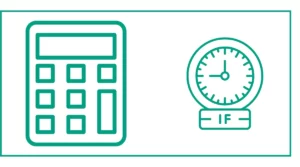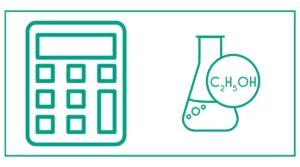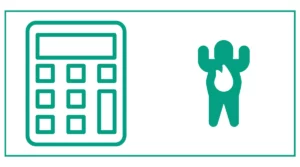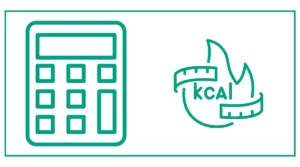Anaerobic Threshold Calculator
Anaerobic Threshold:
You can calculate your anaerobic threshold by using this anaerobic threshold calculator.
Enter your age, choose the formula type ( Haskel & Fox formula, Nes Formula, Tanaka, Monahan, and Seals formula), and press the calculate button.
In case you don't know, the degree of effort between aerobic and anaerobic exercise is known as the anaerobic threshold (AT).
While you exercise, your body must transition from aerobic to anaerobic metabolism at a certain point, known as the AT. The AT calculator is a valuable tool for determining exercise intensity during training and competition in endurance sports and games.
Haskel & Fox formula: BPMmax = 220 − age
Nes Formula: BPMmax=211−0.64×age
Tanaka, Monahan, & Seals formula: BPMmax=208−0.7×age

You might want to calculate your 1RM.
The Anaerobic Threshold Calculator is a valuable tool for athletes, fitness enthusiasts, and anyone looking to optimize their training regimen. This calculator helps determine the point at which your body transitions from aerobic to anaerobic metabolism during exercise. Understanding your anaerobic threshold can significantly improve your training efficiency and overall performance.
What is the Anaerobic Threshold?
The anaerobic threshold, also known as the lactate threshold, is the exercise intensity at which lactic acid starts to accumulate in the bloodstream faster than it can be removed. This point marks the transition from aerobic (with oxygen) to anaerobic (without oxygen) metabolism.
When you exercise below your anaerobic threshold, your body can efficiently clear lactic acid. However, once you surpass this threshold, lactic acid begins to accumulate, leading to fatigue and a decrease in performance. Knowing your anaerobic threshold allows you to tailor your workouts for maximum effectiveness.
How the Anaerobic Threshold Calculator Works
The Anaerobic Threshold Calculator uses your age and a selected formula to estimate your maximum heart rate and then calculates your anaerobic threshold. Here's a step-by-step breakdown of the process:
- Enter your age into the calculator.
- Choose a formula for estimating your maximum heart rate.
- The calculator determines your estimated maximum heart rate based on the chosen formula.
- Your anaerobic threshold is calculated as approximately 85% of your maximum heart rate.
Formula Options
The calculator offers three different formulas for estimating maximum heart rate:
- Haskell & Fox formula: 220 - age
- Nes formula: 211 - (0.64 x age)
- Tanaka, Monahan & Seals formula: 208 - (0.7 x age)
Each formula may produce slightly different results, so it's essential to choose the one that best fits your individual characteristics and training goals.
Using the Anaerobic Threshold Calculator
To use the calculator, follow these simple steps:
- Enter your age in the designated field.
- Select your preferred formula from the dropdown menu.
- Click the "Calculate Anaerobic Threshold" button.
- View your estimated anaerobic threshold in beats per minute (bpm).
For example, if you're a 28-year-old athlete using the Haskell & Fox formula, the calculator would estimate your maximum heart rate as 192 bpm (220 - 28) and your anaerobic threshold as approximately 163 bpm (85% of 192).
Interpreting Your Results
Once you have your anaerobic threshold estimate, you can use this information to structure your training zones and improve your workouts. Here's how to interpret and apply your results:
Training Zones
- Zone 1 (Recovery): Below 75% of anaerobic threshold
- Zone 2 (Aerobic): 75-85% of anaerobic threshold
- Zone 3 (Tempo): 85-95% of anaerobic threshold
- Zone 4 (Lactate Threshold): 95-105% of anaerobic threshold
- Zone 5 (VO2 Max): Above 105% of anaerobic threshold
Using our previous example of a 163 bpm anaerobic threshold, your training zones would be:
- Recovery: Below 122 bpm
- Aerobic: 122-139 bpm
- Tempo: 139-155 bpm
- Lactate Threshold: 155-171 bpm
- VO2 Max: Above 171 bpm
Applying Your Anaerobic Threshold to Training
Understanding your anaerobic threshold and training zones allows you to structure your workouts more effectively:
- Endurance Training: Spend most of your training time in Zones 1-3 to build aerobic capacity and improve fat burning.
- Threshold Training: Incorporate workouts at or slightly above your anaerobic threshold (Zone 4) to improve your body's ability to clear lactic acid.
- High-Intensity Intervals: Use Zone 5 for short, intense bursts to improve VO2 max and anaerobic capacity.
- Recovery: Use Zone 1 for active recovery between hard workouts or during cool-downs.
Limitations of the Anaerobic Threshold Calculator
While the Anaerobic Threshold Calculator provides a useful estimate, it's important to recognize its limitations:
- Individual Variations: The calculator uses general formulas and doesn't account for individual differences in fitness level, genetics, or training history.
- Accuracy: The 85% of maximum heart rate estimate is a general guideline and may not be precise for everyone.
- Changes Over Time: Your anaerobic threshold can change as your fitness improves, so regular reassessment is necessary.
For more accurate results, consider performing a field test or consulting with a sports physiologist for laboratory testing.
Improving Your Anaerobic Threshold
To improve your anaerobic threshold and overall fitness, consider incorporating the following strategies into your training:
- Interval Training: Alternate between high-intensity efforts and recovery periods to push your lactate threshold higher.
- Tempo Runs: Sustained efforts at or slightly below your anaerobic threshold can help improve your body's ability to clear lactic acid.
- Progressive Overload: Gradually increase the duration or intensity of your workouts to continually challenge your body.
- Cross-Training: Incorporate different types of exercise to improve overall fitness and prevent burnout.
- Proper Recovery: Allow adequate rest between hard workouts to prevent overtraining and promote adaptation.
FAQ: Anaerobic Threshold Calculator
How accurate is the Anaerobic Threshold Calculator?
The calculator provides an estimate based on age and general formulas. While it's a good starting point, individual factors can affect accuracy. For precise measurements, consider professional testing.
How often should I recalculate my anaerobic threshold?
Reassess every 4-6 weeks or when you notice significant changes in your fitness level. Regular updates ensure your training zones remain appropriate.
Can I use this calculator for all types of exercises?
The calculator is generally applicable to cardiovascular exercises like running, cycling, and swimming. Sport-specific variations may exist.
What if my calculated anaerobic threshold feels too high or low?
Trust your body's signals. If the calculated threshold doesn't align with your perceived effort, adjust accordingly or consider alternative testing methods.
How does knowing my anaerobic threshold improve my training?
Understanding your anaerobic threshold helps you optimize workout intensity, improve endurance, and structure training plans more effectively.





